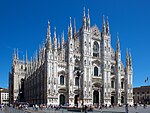Santa Tecla, Milan
345 establishments4th-century churches4th-century establishments in ItalyBasilica churches in MilanItalian church stubs

Basilica di Santa Tecla was a former, paleo-Christian basilica church in Milan, region of Lombardy, Italy. It was originally established in 350 and demolished in 1458. Remnants of the structure have been excavated underneath the Milan Cathedral. According to a number of historians the construction of the Basilica was ordered by Roman Emperor Constans in 345 under the name Basilica Maior. It was then founded in 350.
Excerpt from the Wikipedia article Santa Tecla, Milan (License: CC BY-SA 3.0, Authors, Images).Santa Tecla, Milan
Piazza del Duomo, Milan Municipio 1
Geographical coordinates (GPS) Address Phone number Website Nearby Places Show on map
Geographical coordinates (GPS)
| Latitude | Longitude |
|---|---|
| N 45.463888888889 ° | E 9.1913888888889 ° |
Address
Duomo di Milano
Piazza del Duomo
20122 Milan, Municipio 1
Lombardy, Italy
Open on Google Maps









